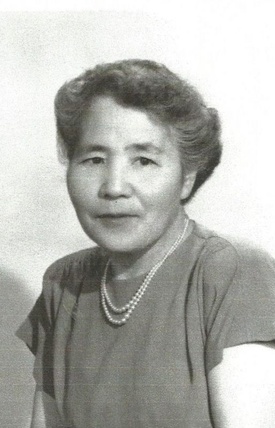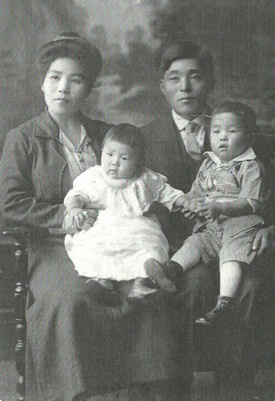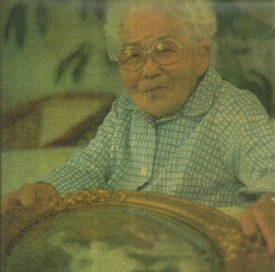If you were walking down the street in Pocatello, Idaho on a Saturday in the 1960’s, there is a good chance you would have run into Miyoshi Okamura- or Mrs. Oki as she was known to many of Pocatello’s residents. Miyoshi was diminutive, less than five feet tall, but nobody doubted her strength or the size of her heart. From the smile on her face and the kind words she spoke, each person she met felt loved and important.
After Miyoshi came to Pocatello as a picture bride in 1914, she adjusted to the many difficulties she encountered as a Japanese immigrant and found success in her new home, leaving a legacy for all her posterity to enjoy. Miyoshi exemplified perseverance and the concept of shikata ga nai, which means “that which cannot be helped,” as she adapted to her new life in Idaho.1
Miyoshi Yokota Okamura was born in the Kochi prefecture on the island of Shikoku, Japan in 1894, as the Mejii era came to an end.2 In a transformation known as the Mejii Miracle, Japan had moved from a feudal society isolated for centuries to a fully modern nation. Part of the transformation included a change in the education system that shaped Japanese culture. Girls learned the ideal of ryosai kenbo, “good wife, wise mother” in school, a concept designed by the Mejii government that unified and nationalized Japan.3
Miyoshi learned these values in her youth so when she arrived in Pocatello, they were part of who she was. Women also learned to obey and submit to their fathers and then their husbands in the Japanese culture.
Miyoshi’s family arranged her marriage to Kameji Okamura. She exemplifies the experiences of an estimated 6,000 to 20,000 Japanese picture brides who immigrated to the West between 1900 and 1920.4 The practice of picture brides coming to the U.S. fit the traditional practice of families arranging marriages in Japan.
Kameji probably sent a picture of himself to his family in Kochi, requesting their help in finding him a bride. With the assistance of a go-between, and her family, his family chose Miyoshi. Kameji received a picture of Miyoshi and accepted his family’s choice. The two families made arrangements, and they held a wedding ceremony with a proxy standing in for Kameji. With Miyoshi’s name added to the family register, she applied to go to the United States.
As with most young women, she felt she had no say in the decision. She did as her parents wished. This is not to say that Miyoshi did not want to go to America. With such an outgoing personality, Miyoshi probably looked forward to the adventure of going to America. Not one to back down from a challenge, as her life shows, she would have been excited to go even though it was so difficult to leave her family.
Miyoshi probably traveled with many other picture brides on the Mexico Maru.5 Aboard the ship, the women had their first experience with American foods and utensils. She might have been one of the many women who mistook a nob of butter for an egg yolk. What a surprise as she put the whole thing in her mouth! Japanese did not use butter and it took many immigrants a while to get used to the taste. The American diet often included meat. Japanese ate little meat and when they did they sliced it thinly. On the ship, passengers regularly ate meat on the bone. Miyoshi might very well have found it revolting.6
Miyoshi and Kameji married in a ceremony in Tacoma, Washington, nineteen days after the ship docked.7 Once the women arrived at the ports, authorities carefully screened picture bride immigrants for health problems before they met their new husbands. Health issues often delayed immigrants from a few days to weeks. Miyoshi waited until the problem cleared and then met Kameji.
In the Seattle area, Miyoshi exchanged her kimono and clogs for western clothes and shoes. All she had known quickly changed. She didn’t speak English, did not know how to cook with the food available in the area, and housework required different chores than in Japan. As an immigrant himself, Kameji knew the difficulties of adjusting and helped Miyoshi with the transition once they arrived in Pocatello. Her thoughtful husband hired a man to teach her English and a woman to help her learn housekeeping skills. Miyoshi found mopping the worst chore. In Japan no one mopped because no one wore shoes in the house.
Miyoshi couldn’t see the ocean as she may have from her home on Shikoku. It kept her homesick as she made these tough adjustments.8 Miyoshi learned to speak and write English but never became fluent. Because of Miyoshi’s outgoing personality, her lack of knowledge of the language did not deter her from interacting with others in the community. Miyoshi persevered to adjust to her new life in Idaho.
In March of 1915, Miyoshi gave birth to her first child, Paul Takeyoshi. A year later, daughter Mary was born. She died in December of the same year of influenza, during an outbreak that foreshadowed the 1918 epidemic. Losing her eight month old daughter must have amplified Miyoshi’s homesickness and caused her much heartache. But life did not allow Miyoshi to focus on her loss. She accepted “that which cannot be helped,” and moved on.
Already pregnant with their third child, Kimi, who was born in April of 1917, Miyoshi persevered. Miyoshi and Kameji had seven children altogether, two boys and five girls. She must have been tired constantly, taking care of the children and helping on the farm.
Miyoshi’s husband’s kind, loving personality showed in the way he actively served his community. He helped organize the Pocatello Japanese Association, received a silver urn from the Japanese Farmer’s Association, and obtained a section in the Mountain View Cemetery for Japanese families. No doubt, Miyoshi supported Kameji in all he did.
Kameji worked hard to make his business, Okamura Gardens, profitable. He had a list of firsts in Pocatello including being one of the first to build a cellar that a truck could drive clear through. He also introduced the cultivation of jumbo celery in the area. Each Armistice Day, Kameji decorated a delivery truck and participated in Pocatello’s parade. He threw celery instead of candy. Kameji appreciated his customers and gave out calendars and Christmas gifts each year.
Tragically, Kameji died in an automobile accident on his way home from helping a friend put out a haystack fire at Fort Hall in October 1930. He was only forty-three. At the age of thirty-six, Miyoshi became a widow with six children ranging from fifteen to four. Because Kameji was so highly endeared by the community Miyoshi found herself overwhelmed by the support they received after his death. The community reciprocated many times over the kindness and generosity Kameji showed to others. Miyoshi and the children received clothes, Christmas gifts, and even Easter baskets from thoughtful friends and colleagues concerned for their welfare.
Again, Miyoshi did not have time to feel sorry for herself or her family for long. With Kameji’s death, any of Miyoshi’s dreams of returning permanently to Japan evaporated. The family’s survival depended on managing the farm well enough to ensure they had enough money. Her oldest son, Paul, quit school and helped her run the business full time.
With the challenges life threw at Miyoshi, she exhibited the quality of Shikata ga nai– “it cannot be helped” as she pressed on, caring for her children and the crops. Daughter Minnie Maruji recalled rising at five each morning and working in the garden before school and again after school until far past dark. The children returned home to do their house chores, which included peeling potatoes for breakfast the next morning. They finished homework after that; their mother making sure they completed it.9 Fried potatoes were always part of breakfast which also included eggs and often oatmeal. Miyoshi never learned some cooking skills but she had friends who helped her. Kimi remembers Mrs. Fisher made them a cake. Miyoshi gave cabbages to her German friend and in turn her friend made sauerkraut that she shared with the Okamura family.10
With such a large garden to take care of, Miyoshi hired others to help. Many youth in the Pocatello community recalled their first jobs weeding vegetables for Mrs. Oki at five cents a row. She tipped them a penny if they did a good job. At a quarter mile in length for each row, the youth certainly earned their money. She grew and sold vegetables until the owners of the land she rented sold the property to make way for a car dealership.11
April 15, 1954, Miyoshi became a U.S. citizen.12 It took a year of studying for her to pass the exam, but it was one of the proudest moments in her life. Like other Japanese immigrants, Miyoshi wanted to prove her loyalty to her adopted nation and show how she loved being here. She is a great example of how many Japanese Americans persevered despite legal barriers to American citizenship for Japanese immigrants.
Miyoshi finally returned to Japan to visit her family in the same year. While visiting, she realized during the forty years in she lived in America she had exchanged many old practices for new ones. Unaccustomed to eating fish at every meal as her parents did, Miyoshi yearned for meat and begged her mother to let her kill a chicken. Her mother unhappily consented to the killing of one of her pets.13
Miyoshi also stayed busy in the Pocatello community in her later years. As an active member of the Pocatello Buddhist Church, she often sang at weddings.14 Miyoshi did not do anything slowly. Many described her as the Energizer Bunny, always going. In her nineties, she still ran up stairs like a woman half her age. Miyoshi kept in touch with her siblings in Japan, writing to them often. She also made sure to send a card for grandchildren or great-grandchildren’s birthdays. Whenever she went somewhere, she often bought something for her grandchildren. She constantly thought of others before herself.15
Raising her six children by herself was not an easy task. Miyoshi knew education was important for her children to fit in and be a positive influence on their families and their communities. All of the children except Paul graduated from high school with honors. What an accomplishment considering the work they did on the farm and at home. Part of their growing up included late nights and hard work. Miyoshi’s children learned from their mother’s example. Their willingness to work hard stuck with each of the children. Her daughter, Kimi, now 98, still works at the family jewelry store in Omaha, Nebraska with her son. She is there until after ten each night. Miyoshi’s son, Roy, was recognized by Sysco Food Services when he retired for not missing a day of work in 30 years.16 Another sibling helps at the florist she and her husband started more than sixty years ago.
When it came to being generous and kindhearted toward others, Miyoshi shined. Her daughter, Minnie Maruji, shared an experience after her mother passed away. Minnie always took flowers to her mother’s grave on her birthday each year. One year, as she pulled up, she noticed a woman at her mother’s grave. As she walked up, she asked the woman if she knew her mother. Excitedly, the woman asked, “Mrs. Oki was your mother?” Minnie replied she was and asked how she knew her. The woman told her how kind Miyoshi had been to her and her children when they were very poor. Miyoshi often gave her vegetables and candy for her children. In addition, each year they got together for lunch on her mother’s birthday, or close to it. She told Minnie that her mother was the kindest person she knew.
Quietly, Minnie cried as she described how loving her mother was to all those she met. Minnie took her mother shopping each Saturday. Remorse filled her voice as explained her own impatience at her mother as she stopped to speak with each person she met. Minnie wanted to finish the shopping and get on with her day. As an 89 year old grandmother now herself, she realizes the kindness and love her mother exemplified to each person she came in contact with.17 Miyoshi lived to be 99 years old and lived sixty-three years as a widow but her spirit of kindness and perseverance lives on in her family and her community.
Notes:
1. Storrs, Debbie.”Like a Bamboo: Representations of a Japanese War Bride. Asian American Women,” The “Frontiers” Reader. Edited by Linda Trinh Vo and Marian Sciachitano. University of Nebraska Press. p. 113. Google Books. 2004.
2. Paul Okamura Jr, Family Group Record. September 3, 1991.
3. R. Okamura, “Changing Ideal of Ryosai Kenbo through Cultural Analysis of Japanese Women in Japan and in the United States: Reexamining the Experience of Japanese Immigrant Women Until 1945.” Order No. 3588471, Oklahoma State University, 2013.
4. Kei Tanaka, “Japanese Picture Marriage in 1900–1924 California: Construction of Japanese Race and Gender.” Order No. 3066787, Rutgers, The State University of New Jersey, New Brunswick, 2002. Takana states, “According to records of the immigration stations in San Francisco and Seattle, 7,018 picture brides entered the United States through these two ports between 1912 and 1920.”
5. Ship’s manifest, Mexico Maru, April 11, 1914
6. Linda Tamura, The Hood River Issei: An Oral History of Japanese Settlers in Oregon’s Hood River Valley, (Urbana and Chicago: University of Illinois Press. , 1949).
7. Paul Okamura Jr, Family Group Record. September 3, 1991.
8. Alice Elison, “Picture Bride,” Idaho Falls, Idaho Post Register. May 23, 1991.
9. Minnie Maruji, Phone interview by author. February 11, 2015.
10. Kimi Takechi, Phone interview by author. February 12, 2015.
11. Alice Elison, “Picture Bride,” Idaho Falls, Idaho Post Register. May 23, 1991.
12. “26 Persons Get Citizenship,” Idaho State Journal, Pocatello, Idaho, November 19, 1954.
13. Alice Elison, “Picture Bride,” Idaho Falls, Idaho Post Register. May 23, 1991.
14. “Ann Kanomata, Ben Kawakami Recite Vows in Church Rites” Idaho State Journal, December 10, 1967.
15. Minnie Maruji, Phone interview by author. February 11, 2015; Miyoshi Okamura, personal correspondence to Paul Okamura. Nd.
16. Irene Chang, “Retiree Ends a Record Streak,” Los Angeles Times. December 30, 1990.
17. Minnie Maruji, Phone interview by author. February 11, 2015.
*This article was originally published by the Angel Island Immigration Station Foundation.
© 2015 Angel Island Immigration Station Foundation





